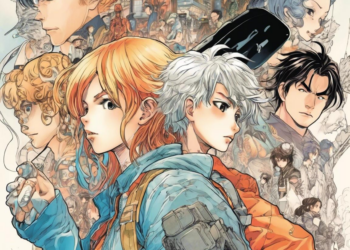How to Start Reading Manga: A Beginner’s Guide

Are you curious about the world of manga but don’t know where to start? You’re not alone! Manga, the popular form of Japanese comics, has become a global phenomenon, captivating readers with its diverse stories, stunning artwork, and engaging characters. This comprehensive guide will walk you through everything you need to know to dive into the exciting world of manga, from choosing your first series to understanding the reading order.
1. Understanding the Basics of Manga
Before diving into your first manga, it’s helpful to grasp the fundamentals. Manga is typically read from right to left, which may feel unusual if you’re accustomed to reading Western comics. The panels flow from right to left and then down the page, mirroring the way Japanese writing is read.
2. Exploring Different Genres of Manga
One of the most appealing aspects of manga is its vast array of genres, catering to a wide range of interests. From action-packed adventures to heartwarming romances, there’s something for everyone. Here are some popular manga genres to consider:
-
Shonen: Primarily targeting young boys, shonen manga often features action, adventure, and themes of friendship and perseverance. Popular examples include Dragon Ball, Naruto, and One Piece.
-
Shojo: Focused on young girls, shojo manga often explores themes of romance, love, and personal growth. Examples include Fruits Basket, Cardcaptor Sakura, and Ouran High School Host Club.
-
Seinen: Aimed at young men, seinen manga covers a broader range of themes, including mature topics like social commentary, psychology, and historical fiction. Popular examples include Attack on Titan, 20th Century Boys, and Monster.
-
Josei: Targeted at young women, josei manga often deals with more realistic and relatable themes, such as relationships, careers, and family life. Popular examples include Yotsuba to!, Emma, and Honey and Clover.
-
Slice of Life: This genre focuses on everyday life and explores the mundane moments that make up our experiences. Examples include Azumanga Daioh, K-On!, and Natsume’s Book of Friends.
-
Horror: Manga can be incredibly chilling, with captivating stories that explore the dark side of human nature. Popular examples include Uzumaki, Gyo, and Junji Ito’s Collection.
3. Choosing Your First Manga Series
With so many options, choosing your first manga series can be daunting. Consider your interests and explore different genres to find a series that appeals to you. Here are some tips to help you decide:
-
Read reviews and summaries: Websites like MyAnimeList, Goodreads, and MangaUpdates offer detailed reviews and summaries of manga series.
-
Check out popular series: Explore popular manga series that have gained widespread recognition, such as Death Note, Fullmetal Alchemist, and Attack on Titan.
-
Browse recommendations: Ask friends, family, or fellow manga enthusiasts for recommendations based on your interests.
-
Start with a single volume: Many manga series have multiple volumes. Consider starting with a single volume to get a feel for the story and art style before committing to a longer series.
4. Where to Find and Read Manga
There are several ways to access manga, both physically and digitally:
-
Physical Copies: You can find manga in bookstores, libraries, and online retailers like Amazon and Barnes & Noble.
-
Digital Platforms: Several digital platforms offer a wide selection of manga, including:
-
Shonen Jump: Offers a free subscription with limited access and a paid subscription for unlimited reading.
-
ComiXology: Offers a vast library of manga with purchase options and a subscription service.
-
Kindle Unlimited: Includes a selection of manga within its subscription service.
-
Manga Plus: A free platform run by Shueisha that provides access to the latest chapters of popular manga series.
-
5. Reading Manga Online: Exploring Legal Options
If you prefer reading manga online, it’s essential to use legal and ethical sources. Many websites offer pirated versions of manga, but supporting these sites harms the creators and the manga industry. Choose legal platforms like those mentioned above, and consider purchasing physical or digital copies to support your favorite artists.
6. Understanding Manga Terminology
Manga often uses unique terminology that might be unfamiliar to newcomers. Here are some common terms:
-
Tankobon: A single volume of a manga series, typically containing around 200 pages.
-
Chapter: Individual units of a manga story, similar to chapters in a book.
-
Volume: A collection of chapters, typically bound together as a single book.
-
Arc: A storyline within a larger manga series, often with a distinct plot and characters.
-
Manhwa: Korean comics that are similar to manga in style and format.
-
Manhua: Chinese comics that share similarities with manga.
7. Tips for Enjoying Manga
Once you’ve chosen a manga series, here are some tips to enhance your reading experience:
-
Start with a popular series: Popular manga series often have well-developed characters and compelling storylines, making them an excellent starting point for newcomers.
-
Explore different genres: Don’t limit yourself to one genre. Experiment with different styles and find what you enjoy the most.
-
Pay attention to the art style: Manga artists have unique styles that contribute to the overall experience. Appreciate the detail and emotion conveyed through the artwork.
-
Read with a good light source: Manga is often printed in black and white, so it’s essential to have good lighting to enhance readability.
-
Take breaks: Reading manga can be immersive. Take breaks to avoid eye strain and allow yourself time to process the story.
8. The Future of Manga: A Growing Trend
The popularity of manga continues to grow globally, with more and more readers discovering its unique storytelling and captivating artwork. With the rise of streaming services, digital platforms, and international collaborations, the future of manga looks bright, promising even greater accessibility and a wider range of stories for all to enjoy.
9. Exploring Manga Adaptations: Anime and Live-Action
Many popular manga series have been adapted into anime, live-action films, and television shows. Watching these adaptations can be a fun way to experience the story in a different format and witness how the characters and storylines translate to other mediums.
10. Engaging with the Manga Community
Join online forums, social media groups, and online communities dedicated to manga. Connect with fellow fans to discuss your favorite series, share recommendations, and learn more about the world of manga.
11. Discovering Manga Artists and Creators
As you delve deeper into the world of manga, explore the work of various artists and creators. Appreciate their unique styles, storytelling techniques, and the impact they’ve made on the manga industry.
12. Supporting the Manga Industry
One of the best ways to support the manga industry is to purchase official copies of your favorite series, either digitally or physically. You can also attend manga conventions, support independent manga artists, and contribute to the thriving community surrounding this beloved art form.
Conclusion
The world of manga offers a rich tapestry of stories, characters, and experiences. With this beginner’s guide, you have the tools to embark on your own manga journey, discover new favorites, and immerse yourself in a captivating world of imagination and creativity. So, grab a volume, open it up, and let the adventures begin!












